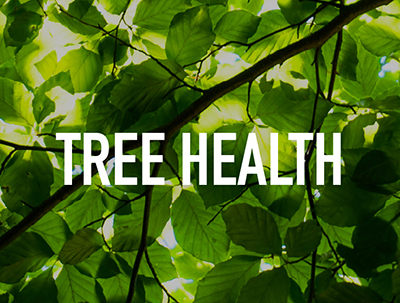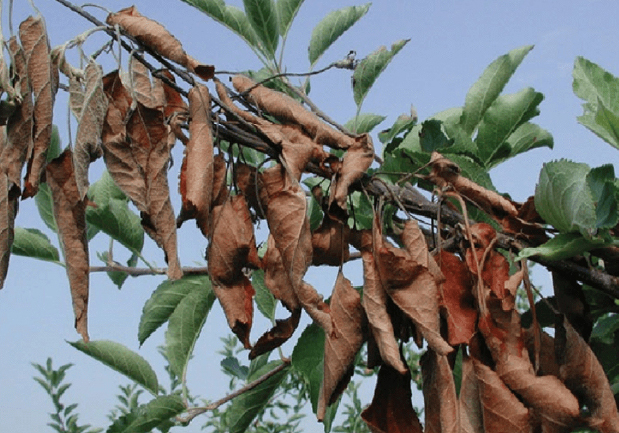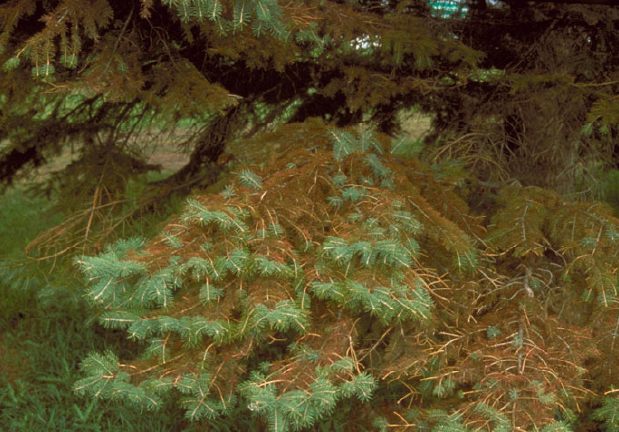

Integrated Pest Management prevents the overuse of pesticides and promotes the responsible application of insecticides and fungicides while protecting the environment. The purpose is to identify tree insect infestation, disease, or cultural problems and to evaluate the threat to plant health and the aesthetic value for trees and shrubs.
We make recommendations for concerns that require immediate attention: if the concern should be put on a watch list or if treatment should be done the following year. Many tree diseases don’t pose an immediate threat to the health of the tree, so delaying treatment for a season doesn’t pose an undue risk to the overall health of the tree. However, this is not true of some vascular wilt diseases like Dutch Elm Disease and Oak Wilt.



Apple Scab is a fungal disease that affects primarily crab apple and apple trees, pear trees, and serviceberry trees. It can infect both plant leaves and fruit. Some co-occurring and/or look-alike issues are:
Armillaria Root Rot fungi form several different structures depending on location and type of tissue infected. The fungus forms white mycelial fans under the bark of infected trees that feed on both live and decaying wood. Co-occurring and/or look-alike issues are:
Bacterial Wetwood/Slime Flux is bacterial genera that appears as vertical streaks from liquid seeping out of cracks or wounds from bark. Bacteria enter from the soil into bark inclusions in the root flare, or from the air into included branch unions or wounds, and then colonizes the heartwood of trees. Co-occurring and/or look-alike issues are:
Bronze Birch Borer is a wood beetle from North America. The larvae are unseen, feeding on the vascular tissue under the bark. The Bronze Birch Borer usually attacks trees which are already stressed or in decline. Some co-occurring and/or look-alike issues are:
Bur Oak Blight is a fungal disease which affects bur oak trees with small acorns, which are primarily found in Minnesota and Iowa. It causes the browning and losing of leaves. Some co-occurring and/or look-alike issues are:
Cedar-Apple Rust can cause defoliation and reduction of fruit quality. Rust diseases have a complex life cycle requiring two hosts to complete. Some co-occurring and/or look-alike issues are:
Cedar-Quince Rust is a fungus that affects various cedars, junipers, and trees belonging to the rose family (Rosaceae). Quince, pear, apple, hawthorn and crab apple trees can all be potential hosts of this disease. Some co-occurring and/or look-alike issues are:
Diplodia Shoot Blight is a fungal disease that affects the shoots. If trees are unstressed and healthy, infection is stopped by killing new shoots. Trees generally recover quickly. If trees are stressed, the fungus will spread into mature tissue. This causes cankers and whole branch death, resulting in a slow decline of the tree. Some co-occurring and/or look-alike issues are:
Dothistroma Needle Blight is a fungal infection that can eventually cause the entire needle to die and fall early. Some co-occurring and/or look-alike issues are:
Dutch Elm Disease is a fungal disease that affects elm and zelkova trees. Elm bark beetles spread the fungus from tree to tree, and the disease can also spread between roots. Some co-occurring and/or look-alike issues are:
Emerald Ash Borers are destructive beetles that feed off all native ash trees. Some co-occurring and/or look-alike issues are:
European Pine Sawfly is an insect which during its larval stage causes damage to several different species of pine. As larvae mature, they begin eating entire needles down to the base, leaving just the fascicle. Some co-occurring and/or look-alike issues are:
Fire Blight is a plant disease that results in wilting and dying of plant parts. Bacteria is transmitted by insects and moist air currents to young green tissue, especially after a storm that causes physical damage to plant shoots. Some co-occurring and/or look-alike issues are:
Gall Wasps leave a gall on leaves which provides the developing gall wasp with protection for the most vulnerable stage of its life cycle. Gall wasp larvae can also cause trees to form galls on leaf midrib veins which can disfigure leaves, reducing their ability to photosynthesize effectively. Some co-occurring and/or look-alike issues are:
Hackberry Psyllids are aphid-like insects that cause the galls commonly seen on the underside of tree leaves. Adults lay eggs on newly developing leaves in spring, with nymphs hatching shortly thereafter. Nymphs begin to feed by sucking sap out of the leaves, which also causes the leaf to form a gall or malformed tissue around the nymph. Some co-occurring and/or look-alike issues are:
Hawthorn Leafminers lay their eggs on healthy, newly emerging leaves. Their larvae burrow into the inner leaf, feeding off healthy tissue near the tip, and killing or disfiguring the leaves. Some co-occurring and/or look-alike issues are:
Honeylocust Plant Bug eggs hatch in the spring, having been burrowed all winter. Just as leaf buds begin to open, the young bugs feed off the new foliage, causing mostly cosmetic issues, though some heavily damaged leaves could fall early. Some co-occurring and/or look-alike issues are:
Iron and Manganese Chlorosis is the reduction in the production of chlorophyll in leaves of affected trees caused by insufficient elemental iron or manganese in the leaf. It can affect all plants, but is mostly seen on eastern white pine, red maple, river birch, and northern pin oak. Some co-occurring and/or look-alike issues are:
Japanese Beetles destroy plants both at the root and the leaf. Young beetles, or grubs, live underground and feed off the roots of plants and grass. Adult beetles prefer the leaf tissue of Little-Leaf Linden, Birch, Elm, Pin Oak, Rosaceae, particularly roses, pome, and stone fruits, and both wild and cultivated grapes or other vines.
The Magnolia Scale is one of the largest scale insects, known to inhabit the Magnolia tree. Nymphs suck sap out of twigs and leave a honeydew residue, which can attract other insects and cause sooty mold to develop. Some co-occurring and/or look-alike issues are:
Maple Eriophyid Mites are maple bladder gall mites and maple spindle gall mites that burrow in dead buds, rough bark, and twigs and feed on newly expanding leaves in the spring. The feeding causes the leaf to develop galls around the mites, which start green, then turn red and eventually black. The damage they cause is typically cosmetic only. Some co-occurring and/or look-alike issues are:
Maple Tar Spot is caused by three species of Rhytisma that cause slightly different lesions but follow the same cycle. Some co-occurring and/or look-alike issues are:
Nectria Canker fungi are generally saprophytic, decaying, or already dead wood, but can become weakly parasitic if infecting weakened, stressed trees. Co-occurring and/or look-alike issues are:
Oak Wilt is a fungal disease that affects all native oaks, with Red Oak and White Oak showing different symptom complexes. The infection spreads much more rapidly in Red Oak varieties than White Oak, due to differences in xylem structure. Some co-occurring and/or look-alike issues are:
Pine Bark Adelgid is where both adults and nymphs feed on the sap in tree trunks and branches. Healthy trees usually sustain moderate infestations without significant damage, but already-stressed trees can be adversely impacted with poor needle color, stunted growth, and eventually branch death. Some co-occurring and/or look-alike issues are:
Pine Needle Scale can be found on all pines and sometimes Douglas Fir, Spruce, and Juniper trees. Females and eggs are protected by the scales as they lay eggs and then hatch. Some co-occurring and/or look-alike issues are:
Rhizosphaera Needle Cast is a fungal disease that affects predominantly Colorado Blue Spruce, White Spruce, and Black Hills Spruce. Some co-occurring and/or look-alike issues are:
Spruce Spider Mite is an insect that sucks fluid from needles when feeding, resulting initially in a speckled, mottled, or flecked appearance. As feeding continues, the needles begin to look rusty and can fall prematurely. Some co-occurring and/or look-alike issues are:
Tent Caterpillars feed off most woody trees and shrubs and lay eggs in Oak, Aspen, and Sugar Maples. The eggs hatch and larvae build tents and feed at night. As they mature, the caterpillars rest in the tents during the day. While heavy feeding can cause defoliation, trees generally recover after larvae have hatched. But cosmetic damage can be significant and should be addressed as soon as possible. Some co-occurring and/or look-alike issues are:
Two-Lined Chestnut Borer is an insect that invades all native oaks, and occasionally chestnut, ironwood, and beech trees. The insect emerges in May or June and feeds on the leaves, causing some damage. The greater damage is done as they lay eggs underneath the bark, and the larvae burrow underneath, feeding on the cambial zone. Some co-occurring and/or look-alike issues are:
From questions to estimate requests, contact us about your residential or commercial project.